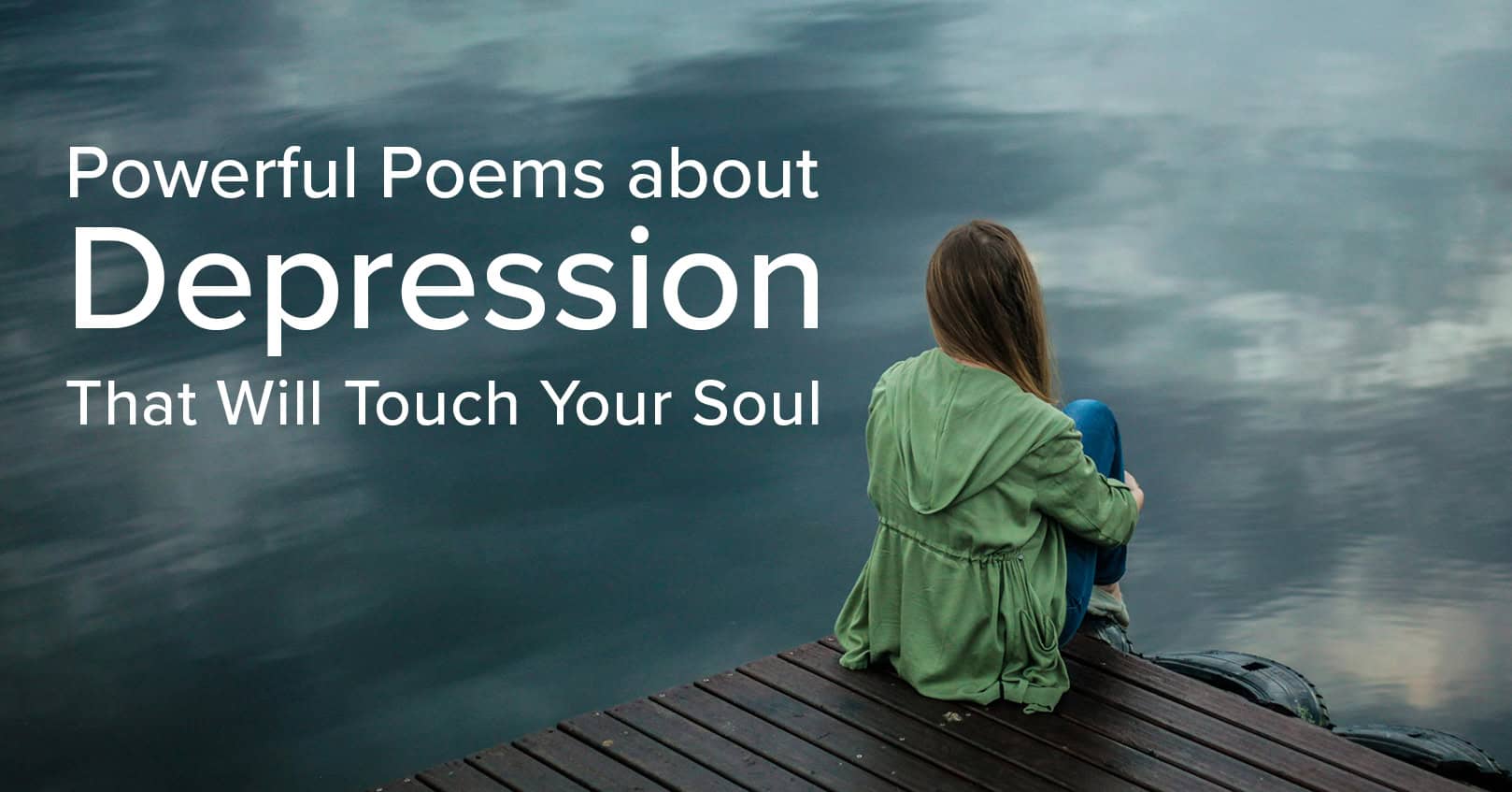
Poetry offers a special perspective into the human condition, particularly when it comes to complex emotions like depression. Poets utilize verse to convey feelings like loneliness, hopelessness, and depressing times that often seem indescribable. In times of darkness, poetry can be a powerful reminder that we are not alone and that our feelings—no matter how heavy—are shared by others. There is solace in knowing that others have walked a similar path and have expressed those struggles with such raw and relatable honesty.
These poems offer a chance to think, heal, and realize that even in our darkest moments, there is empathy, connection, and hope—whether you’re seeking comfort or a way to communicate your feelings. Poetry frequently highlights the resiliency and power that can manifest amid intense emotional suffering, in addition to reflecting our inner battles. Here are 25 poems to hopefully touch your heart and help you feel less alone.
1. “I Am Not I” by Juan Ramón Jiménez
“I am not I.
I am this one
Walking beside me whom I do not see . . .”
A common experience during depression is feeling disconnected from oneself, which is reflected in Jiménez’s poetry. However, the poem also offers hope by implying that the real self—the one passing by—is still there, even though we can’t always see it. One common step in the recovery process from depression is discovering our “hidden self” once more and recognizing that the person we want to be is still within of us, just waiting to come out.
Read the full poem here.
2. “Tulips” by Sylvia Plath
“The tulips are too excitable, it is winter here.
Look how white everything is, how quiet, how snowed-in . . .”
In “Tulips,” Plath explores the suffocating numbing of melancholy and contrasts it with the tulips’ wonderful invasion of life. The speaker’s need for peace is broken by the flowers. Despite addressing the enormous depth of sentiments during despair, this poetry gives a glimmer of hope. Tulips are a representation of life enduring in spite of numbness, letting us know that no matter how far away we feel, life may bring us back to life.
Read the full poem here.
3. “The Fury of Rainstorms” by Anne Sexton
“The rain drums down like red ants . . .”
Sexton effectively illustrates the relentless pounding of emotions by drawing a comparison between melancholy episodes and a storm. The rain symbolizes emotional turmoil even though the storm is just temporary. If we see depression as a storm to be weathered—something that comes and goes—we could realize that these feelings will eventually pass, like any other storm. The key is to not let them overwhelm you, but to embrace them as a natural part of life’s ups and downs.
Read the full poem here.
4. “The Guest House” by Rumi
“This being human is a guest house.
Every morning a new arrival . . .”
Rumi’s poetry offers an alternative viewpoint on depression. By comparing them to guests in a home, the poem exhorts us to embrace all emotions, even grief, as guests with lessons to teach. Instead of resisting or detesting negative emotions, Rumi suggests viewing them as opportunities for growth. Even during difficult times, we can find peace by understanding that all feelings, like guests, are temporary and will eventually leave.
Read the full poem here.
5. “Kindness” by Naomi Shihab Nye
“Before you know what kindness really is,
you must lose things . . .”
According to Nye’s “Kindness,” deep empathy and understanding are often derived from pain and loss. This poem is a reminder that empathy and the capacity for compassion toward others and ourselves are fostered by pain. Even while sadness can be isolating, if we recognize that it teaches us something valuable, we can begin to shift our perspective and see it as a step toward greater knowledge and connection rather than as a barrier.
Read the full poem here.
6. “Aubade” by Philip Larkin
“I work all day, and get half-drunk at night . . .”
In a brutally honest way, Larkin’s “Aubade” tackles death and the accompanying existential anxiety. Despite dealing with harrowing fears, Larkin’s unapologetic honesty about the human condition encourages readers to confront their anxieties. According to this poetry, we can embrace death and the transient nature of life and discover our life’s purpose by facing the inevitable end of life.
Read the full poem here.
7. “Having It Out with Melancholy” by Jane Kenyon
“If many remedies are prescribed for an illness,
you may be certain that the illness has no cure . . .”
Kenyon’s poem personifies depression as an old enemy, addressing it head-on. While acknowledging that depression is a persistent and difficult battle, the poem also suggests that we might regain some control by recognizing and facing our melancholy. Instead of letting depression rule us, we should learn to manage it and acknowledge its existence.
Read the full poem here.
8. “Not Waving but Drowning” by Stevie Smith
“I was much further out than you thought
And not waving but drowning.”
When screams for assistance are misinterpreted as displays of strength, Smith’s poetry tackles the sensation of being misinterpreted. Even those who are closest to us often fail to see sadness, the poem says. It acts as a reminder that effectively communicating our feelings and reaching out to others are the keys to overcoming loneliness. Additionally, it demands that people become more sensitive to the unseen hardships of those in their immediate vicinity.
Read the full poem here.
9. “The World Is Too Much with Us” by William Wordsworth
“The world is too much with us; late and soon,
Getting and spending, we lay waste our powers . . .”
Wordsworth laments the detachment of contemporary life from religion and the natural world. His poem argues that the pressures of society and consumerism can lead to depression and have a detrimental effect on our mental health. The poem also offers a cure, though, which is to reconnect with nature and find peace apart from social demands. It can provide readers calm and stability by encouraging them to seek out meaning and simplicity in the natural world.
Read the full poem here.
10. “Funeral Blues” by W.H. Auden
“Stop all the clocks, cut off the telephone,
Prevent the dog from barking with a juicy bone . . .”
“Funeral Blues” expresses deep sorrow and the notion that, in times of significant loss, life ought to come to a halt. The poem is about sadness, but it also shows how hopelessness can make everything seem quiet and muted. However, by giving expression to this powerful sense of loss, Auden provides a way to process grief and begin the healing process. Recognizing suffering is the first step toward conquering it.
Read the full poem here.
11. “The Guest House” by Rumi
“This being human is a guest house . . .”
Rumi’s approach in “The Guest House” gives readers consolation and hope by providing a means of healing via acceptance and mindfulness in the face of emotional challenges like despair. It reminds us that every feeling, no matter how terrible, has a purpose in our understanding of the world and ourselves.
Read the full poem here.
12. “Lady Lazarus” by Sylvia Plath
“Dying
Is an art, like everything else.
I do it exceptionally well.”
The story of Plath’s “Lady Lazarus” boldly depicts tenacity in the face of hardship. The poem illustrates the power of resilience and rebirth while simultaneously examining the darkest facets of mental illness. Even after our worst moments, Plath’s portrayal of “rising again” serves as a reminder that we are capable of repairing and rising with renewed vitality. The poem’s combative tone provides readers with the fortitude to conquer their challenges.
Read the full poem here.
13. “Mirror” by Sylvia Plath
“I am silver and exact. I have no preconceptions.
Whatever I see I swallow immediately . . .”
In “Mirror,” Plath explores identity and self-perception, encapsulating the agony of seeing oneself bluntly but cruelly. Like grief, the mirror offers an unfiltered viewpoint that could come out as judgmental and harsh. However, the poem also suggests that the first step to accepting this reflection and continuing on to self-acceptance and healing is acknowledging it.
Read the full poem here.
14. “When I Have Fears” by John Keats
“When I have fears that I may cease to be
Before my pen has glean’d my teeming brain . . .”
Keats masterfully captures the uneasiness that accompanies existential dread as he reflects on the fear of dying and unrealized potential. Nevertheless, the poem also serves as a reminder of the value of present-moment living. We can overcome our fear of missing things and develop a greater appreciation for what we have by acknowledging that life is brief.
Read the full poem here.
15. “We Wear the Mask” by Paul Laurence Dunbar
“We wear the mask that grins and lies,
It hides our cheeks and shades our eyes . . .”
Dunbar’s potent poem examines the pressure from society to conceal genuine feelings beneath a façade. This “mask” stands for how people hide their despair and hardships, especially in a society that demands unwavering resilience. The poem emphasizes how crucial it is to recognize these suppressed emotions and remove the mask in order to embrace emotional openness and genuineness. This poem urges us to seek help and stop concealing who we really are in order to overcome depression.
Read the full poem here.
16. “Hope is the Thing with Feathers” by Emily Dickinson
“Hope is the thing with feathers
That perches in the soul . . .”
In her famous metaphorical poem, Dickinson compares hope to a bird that stays at our side even during our darkest hours. According to this poetry, hope subtly persists and provides comfort when it is least anticipated, despite how debilitating despair may feel. It serves as a reminder that hope, even when it isn’t always visible, is a strong force that may support us throughout difficult times.
Read the full poem here.
17. “Mad Girl’s Love Song” by Sylvia Plath
“I shut my eyes and all the world drops dead;
I lift my lids and all is born again.”
Plath’s “Mad Girl’s Love Song” eloquently conveys the hopelessness and alienation that are sometimes associated with depression. Although the poem conveys a sense of loss and hopelessness, its recurring pattern highlights how cyclical these feelings are, suggesting that they might pass before resurfacing. With the understanding that emotions can alter over time, acknowledging these cycles might help us get through challenging times.
Read the full poem here.
18. “Acquainted with the Night” by Robert Frost
“I have been one acquainted with the night.
I have walked out in rain—and back in rain.”
Walking alone through a pitch-black, never-ending night is how Frost personifies despair in this poem. The act of walking into the night conveys perseverance even yet it speaks to sentiments of loneliness and sadness. The speaker demonstrates that persistence is achievable even in the most trying circumstances by embracing the gloom and pressing on.
Read the full poem here.
19. “It Was Not Death, for I Stood Up” by Emily Dickinson
“It was not Death, for I stood up,
And all the Dead, lie down . . .”
Dickinson considers the bewildering sensation of depression in this reflective poetry. She conveys an understanding of maintaining her composure in the face of overwhelming circumstances, indicating a subtle yet significant strength. The ability to persevere and find a path forward in the face of adversity is affirmed by the act of “standing up” in the face of despair.
Read the full poem here.
20. “The Hollow Men” by T.S. Eliot
“This is the way the world ends
Not with a bang but a whimper.”
“The Hollow Men” addresses the profound feelings of paralysis and disappointment that can accompany despair. By confronting the feelings of emptiness and the fear of facing reality, the poem raises the possibility that there might be a way ahead. The significance of self-reflection is emphasized, demonstrating that genuine development arises from facing hopelessness and taking proactive measures to reconnect with life.
Read the full poem here.
21. “The Raven” by Edgar Allan Poe
“And the raven, never flitting, still is sitting, still is sitting
On the pallid bust of Pallas just above my chamber door . . .”
Poe’s “The Raven” examines the issue of loss and unrelenting sadness, represented by the raven’s refusal to depart. Although the poem is rife with gloom, it also serves as a reminder that healing can result from facing our grief and accepting its existence. Accepting the existence of suffering allows us to start coping mechanisms, even if it never completely goes away.
Read the full poem here.
22. “Do Not Go Gentle into That Good Night” by Dylan Thomas
“Rage, rage against the dying of the light.”
Thomas makes a strong case in “Do Not Go Gentle into That Good Night” to battle against hopelessness and death. The poem’s fierce tone is one of resistance and courage, challenging us to battle against giving up even if it deals with mortality. For people who are struggling with depression, the message of perseverance in the face of tremendous adversity can be motivating.
Read the full poem here.
23. “Leaves of Grass” by Walt Whitman
“I celebrate myself, and sing myself,
And what I assume you shall assume . . .”
Whitman’s “Leaves of Grass” highlights the beauty of the human experience despite its difficulties and the interdependence of all life. Even while the poem discusses how short life is, it also highlights how wonderful it is to live life to the fullest. This poem can assist readers in changing the way they view life by promoting present-moment awareness and gratitude for each moment, especially when faced with sorrow.
Read the full poem here.
24. “On the Death of Anne Brontë” by Charlotte Brontë
“My darling thou wilt never know
The grinding agony of woe . . .”
The profound grief of losing her sister, Anne, is encapsulated in Charlotte Brontë’s moving poem. The poem’s unadulterated intensity captures the depths of grief, even though writing about it is a form of catharsis. This poem serves as a helpful reminder that letting our sadness out, whether it be via writing, speaking, or creating, can help us overcome our suffering rather than bottling it up inside.
Read the full poem here.
25. “Still I Rise” by Maya Angelou
“You may write me down in history
With your bitter, twisted lies . . .”
Maya Angelou’s song “Still I Rise” honors tenacity and personal fortitude. Along with talking about injustice and hardship, the poem highlights the inner strength that enables us to overcome these challenges. This poetry offers hope and empowerment to those who are depressed, letting them know that they may still rise over difficult circumstances and regain their vitality.
Read the full poem here.
Conclusion
These poems don’t just reflect the depths of depression and sorrow—they offer ways to understand, heal, and move forward. Whether through resilience, hope, or confronting our emotions, these works remind us that we’re not alone in our struggles. Poetry helps us process difficult feelings, offering moments of comfort and inspiration even in dark times.
Let these poems serve as a comfort, demonstrating that even while hopelessness can seem overwhelming, there are always ways to bounce back, develop, and find strength. By confronting our emotions, we open ourselves to healing and transformation.
Do you have a favorite poem or quote about depression that really speaks to you? Share with us in the comments below!

















Comments